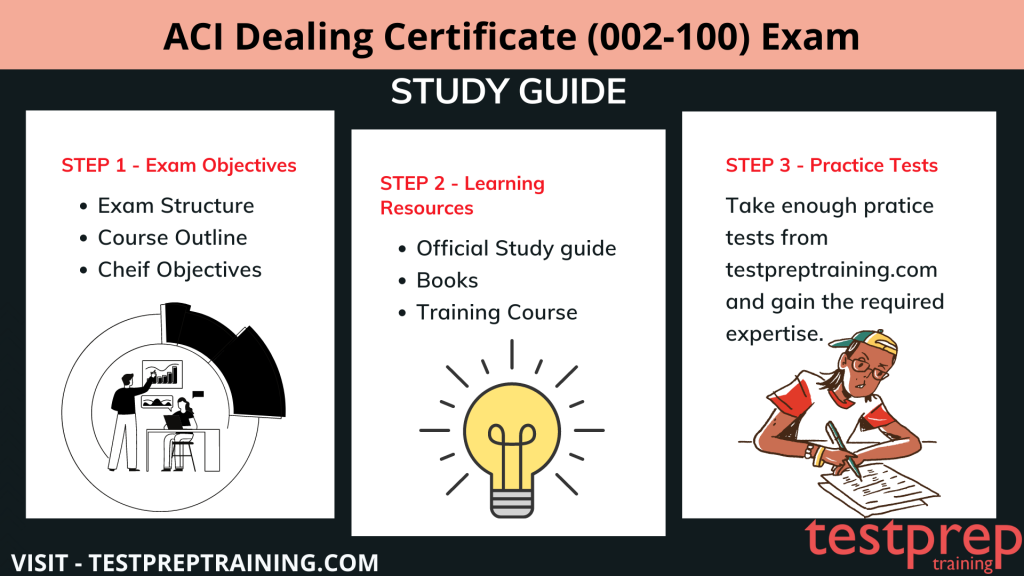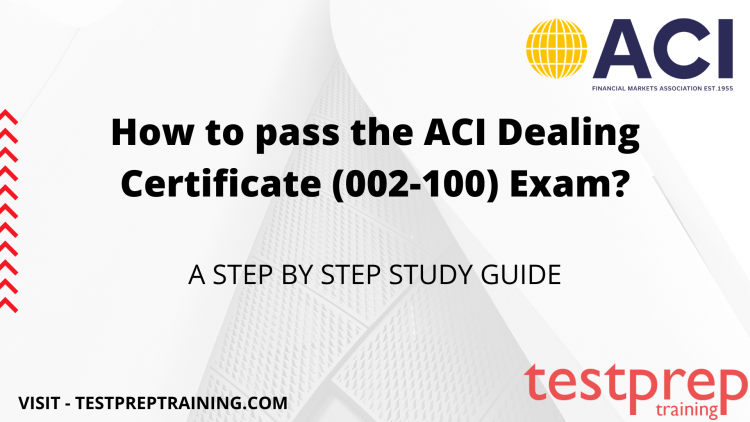The ACI Dealing Certificate (002-100) exam has expired on 31st March 2021. The replacement available is ACI Dealing Certificate New Version
Attaining certifications is not an easy thing, especially in today’s generation, when the competition is high. Industries are in search of the best suitable candidate who can handle the office efficiently. However, there are many competitors on your way, and only a few succeed. Are you also one of them who’s running towards success but is confused about what preparation resources are the best? Are you interested in passing the acquiring the ACI Dealing Certificate (002-100) Exam, and acquiring the ACI Dealing Certificate? If that is the case, then you are in the place. In this article, we have gathered a list of preparation resources to help you with your preparation journey.
The ACI Dealing Certificate (002-100) is a foundation program. It allows candidates to acquire knowledge of the structure and operation of Major foreign exchange and Money markets. The knowledge comprises core products like cash, forwards, and derivatives. It also includes the basic skills for competent participation and the ability to apply fundamental mathematics. The redesigned exam covers various topics like foreign exchange, interest rates, and commodities instruments. Also, comprising their related markets with theoretical and quantitative sessions. In addition to that, the financial markets environment and applications with theoretical questions.
Why get ACI certified?
The American Concrete Institute (ACI) is a highly respected global organization known for its expertise in concrete design and construction materials. ACI is renowned for its use of agreed-upon standards, technical knowledge, educational programs, and certification initiatives. In many national and international building codes, having ACI Certified Personnel on construction sites is a requirement.
Acquiring this title ensures the employer that you will get the job done right with the highest standards. It provides the credentials to build the best concrete structures in the world.
Who should take the exam?
The aspirants of the ACI Dealing Certificate (002-100) are as follows-
- Firstly, recent entrants and junior dealers with 0-18 month’s experience in the dealing room.
- Middle office and operations personnel
- Also, compliance and risk officers
- Auditors and compliance officers
- Finally, serves precursor in ACI Diploma
Exam Details
| Exam Name ACI Dealing Certificate | Code ACI |
| Duration 3 hours | Exam Format Multiple Choice and Multi-Response Questions |
| Exam Type Dealing | Number of Questions 70 Questions |
| Eligibility/Pre-Requisite NIL | Exam Fee Euro 250 (Including all taxes) |
| Exam Language English | Passing Score Pass (60% – 69.99%) ; Merit (70% – 79.99%) ;Distinction (80% and above) |
Now let us head towards the more technical part of your preparation, ie., the course outline. Thoroughly going through the various domains covered in the exam, will help you identify the areas in which your skills will be tested. Moreover, you’ll get to know what are the topics where you already have expertise in, and where you need to give special attention to.
Course Outline
In addition to the topics outlined below, you are expected to be up-to-date with the latest events and changes in the markets. Following are the major 7 Course Domains of the ACI Dealing Certificate (002-100) exam –
Domain 1: Basic Interest Rate Calculations
- Firstly, to understand the principles of the time value of money.
- To be able to calculate short-term interest rates and yields, including forward-forward rates, and to use these interest rates and yields to calculate payments and evaluate alternative short-term funding and investment opportunities.
- Also, understand how information is plotted in a yield curve, the terminology describing the overall shape of and basic movements in a curve, and the classic theories which seek to explain changes in the shape of a curve.
- Finally, they should also know how to plot a forward curve and understand the relationship between a yield curve and forward curves
Domain 2: Cash Money Markets
- Firstly, to understand the function of the money market, the differences, and similarities between the major types of cash money market instruments and how they satisfy the requirements of different types of borrower and lender.
- To know how each type of instrument is quoted, the quotation, value date, maturity, and payment conventions that apply and how to perform standard calculations using quoted prices.
- Finally, given the greater inherent complexity of repo, good working knowledge is required of its nature and mechanics.
Domain 3: Foreign Exchange
- Firstly, to understand and be able to apply the spot exchange rate quotations.
- Understand basic spot FX dealing terminology and the role of specialist types of an intermediary.
- Recognize the principal risks in spot and forward FX transactions.
- Also, Calculate and apply forward FX rates, and understand how forward rates are quoted.
- Understand the relationship between forwarding rates and interest rates and time options.
- Then, to be able to describe the mechanics of outright forwards, FX swaps and forward-forward FX swaps, explain the use of outright forwards in taking currency risk and explain the use of FX swaps in rolling spot positions, hedging outright forwards, creating synthetic foreign currency assets and liabilities, and in covered interest arbitrage.
- Finally, display a good working knowledge and understanding of the rationale for NDFs. To be able to recognize and use quotes for precious metals, and demonstrate a basic understanding of the structure and operation of the international market in precious metals.
Domain 4: Forward-forwards, FRAs and Money Market Futures & Swaps
- Firstly, to understand the mechanics of and how to use money market interest rate derivatives to hedge interest rate risk.
- explain how FRAs, money market futures and money market swaps are derivatives of forward-forward positions, and outline the advantages of derivatives
- Finally, identify the overnight indexes (OI) for euro, sterling, Swiss francs, and US dollars
Domain 5: Options
- Firstly, to understand the fundamentals of options.
- To recognize the principal classes and types, and understand the terminology, how they are quoted in the market, how their value changes with the price of the underlying asset and the other principal factors determining the premium, how the risk on an option is measured and how they are delta hedged.
- Finally, to recognize basic options strategies and understand their purpose
Domain 6: Principles of Asset & Liability Management
- Firstly, to understand the fundamentals of Asset & Liability Management as a practice of managing and hedging risks that arise due to mismatches between the asset side and the liability side of the balance sheets of a bank.
- Explain how main risk factors like funding and liquidity risk, market risk (FX, Interest Rate, Equity, Commodity, etc.), credit risk, leverage risk, business risk, and operational risk are interrelated and how they affect the balance sheet of a financial institution.
- Finally, describe common risk management and hedging techniques that help control these effects and to understand how these techniques are used to set up a state-of-the-art ALM approach.
Domain 7: Principles of Risk
- Firstly, to understand why risk is inherent in banks’ business models and why effective risk management is a key driver for banks’ success.
- Describe major risk groups: credit, market, liquidity, operational, legal, regulatory, and reputation risk. They will understand the significance of risk groups for different banking businesses and units.
- Lastly, techniques and steps required to handle these types of risks and broaden our comprehension to meet the various needs of shareholders, regulators, and debt providers in terms of risk and return
Preparation Guide for the ACI Dealing Certificate (002-100) Exam

Official Study guide
The ACI website offers the syllabus for the Dealing certificate. Also, the syllabus includes reference reads and all necessary documents required. The contents are various topics like financial markets environment, foreign exchange, rates, FCCI derivatives, and also, Financial Markets Applications. Also, the ACI website provides the official ACI formula sheet. It will help greatly with the course. In short, the ACI website has all that you need to pass the exam.
Books
Books are, no doubt, the most reliable friend you can ever have in preparing for any exam. They are your constant support and are always available at your service, to clear all your doubts and enhance your knowledge. Below, we have recommended certain books that will surely help you gain proficiency in attaining the ACI Dealing certificate.
- Mastering the ACI Dealing Certificate: by Mr. Philip J L Parker – It’s a Book about How to pass the ACI Education Level 1 Examination (Financial Times Series).
- Financial markets and the ACI Dealing Certificate by Philip J L Parker – Best book for Treasury professionals and ACI Dealing Certificate aspirants.
- ACI Dealing Certificate questions and answers by Mr. Philip Parker(2019) – This book will help you practice your knowledge and prepare you for the exam.
Training Course
To begin with, thorough preparation is the key to succession. Training courses will help you gain success in the ACI Dealing Certificate. The Financial Markets Academy offers the best-fitted training course. In addition, you will learn the skills in Money markets and Capital markets, ALM and risk, and other major topics.
Practice Tests
Practicing with a mock test is an excellent strategy to vary your study routine and improve your chances of success in the actual exam. Reviewing your answers will pinpoint areas that need extra focus and help gauge how well you align with the exam objectives.
So start practicing for the ACI Dealing certificate Now!



